Enneagram of Personal Life
The Enneagram of Personal Life
© 2006 by Bruno Martin
"That which one wishes for in youth one has in abundance in old age." - J. W. von. Goethe
Each human has a vision or a conception of goals, which he would like to realize in his life. At the beginning of adult life this vision is still shrouded in fog. One asks oneself: "What do I want from life?" "How can I reach it?" "Is there a meaning - and if so, how can I fathom this?"
The seed of the personal life vision sleeps in each human and waits to be unfolded in consciousness in such a way that it can produce fruits in life. Even if it takes sometimes a long time until this vision can unfold, it appears again and again during this phase for short moments on the surface of waking consciousness. The "possibility field" of life brings each human again and again into contact with "spiritual questions" or “question of meaning”. Whether an impulse from this field is accepted or not we ourselves decide due to our life circumstances. Humans always receive new impulses or are in contact with humans, who give them an important suggestion. Sometimes they continue to pursue this impulse, give up however after a while again, or forget it. The available possibilities, whether they are brought into ones own life or even carried out, are unlimited. Particularly in life phases determined by mental problems and crises, if new decisions must be made, the basic spiritual questions can emerge as from a fog. Sometimes one is able to put these questions and the decisions which are connected with them for some time into the “subconscious”, but in many cases there are instants, in which the inner life vision is pushed outwardly so strongly to the surface that one cannot avoid recognizing it. A change has to be decided. “
Visions let the boundary between the known and the unrecognizable disappear.... They twist this simultaneous realnesses into one another, make the invisible visible... - Corolly Erickson
Everyone tries in their own way to solve questions or problems. Some make a decision intuitively; others seize to life assistance pieces of advice. In addition, it is possible to work purposefully on clarifying one’s own thoughts. Only these efforts can give further solutions. This independent elaboration of the recognized goals has the advantage that you don’t simply unreflectedly use pieces of advice, which can be perhaps neither understood nor applicable to one’s own life. To arrive at simple decisions is sometimes easy; however, sometimes many aspects must be weighed out.
"Once I was in the desert..." told a famous adventurer in a table conversation, "I had an entire tribe of terrible and bloodthirsty Beduines racing behind me!" "How did you do that?" asked one. "Very simply! I run away, and they followed me."
The understanding can deepen more, if you work from your own urge and interests to find answers or new cognitions. In this case the insights come from what is your own and the solution will become part of you - and you can also apply it to your life. If you use the method of “Systematics” you can gain your own insights. The method, which I will present you interwoven with concrete practical examples, however are only a tool, they do not give prefabricated answers. Each problem, each conflict, each search for realization can be summarized in a fundamental question.
To formulate a question is the first step to a solution. Even better is to try to ask the right question which already contains the answer.
My following application model is based on the question: how does the human life unfold itself? Is there a basic structure of the development of the life that is common to all persons? How can I transfer this general recognition to my life planning?
The second step is the data collection to these questions.
For this reason it is very practical to write the many single thoughts and ideas to the question without any evaluation on post-it notes or draw a “mind map”. That is very useful, because later on - if it should become more concrete - you can “play” with the notes and sort them differently. If you have yet no clear question, you can begin nevertheless. Write down everything what comes into your mind, any associations which might occur to you, usually the question then steps forth.
My question regarding the path of human life and its phases brought the following thoughts out: We are born, develop our physical and mental abilities, learn, and independent of our parents we grow up, go into education, and take on an occupation. Perhaps we find relationships, create a family, and educate our own children. It can also be that we take other ways. Our life will become ever more manifold, we are getting older and more mature and will look perhaps for new goals at the end of an active working life and unfold new activities. But to life there also belongs the consideration of what we want of life, where it leads, why we live at all. The questions about soul, God, life after death etc. will possibly emerge.
The "world of life" is in spite of its unity actually a multiplicity. We only perceive the general view, instead of the many details that are collected in the unity. We do not see it if we do not focus it. We only see a "semolina" that is not easy to be cooked, yet without cinnamon and sugar (or other ingredients) it wouldn’t have any flavor.
If we begin to recognize the many aspects of a unity we must state that they are almost inexhaustible, never ending.... If you begin to think about a simple thing, more and more thoughts will occur to you. You should not underestimate this exercise under any circumstances, because it supplies valuable material for the further procedure!
Monad
Working this way you have created a Monad. In the system of the Monad many elements coexist without distinction. However, this unity has no structure. A Monad is expressed by its entireness. In systemic thinking with number qualities each system is at the same time a Monad, a unit, which contains all meanings in itself.
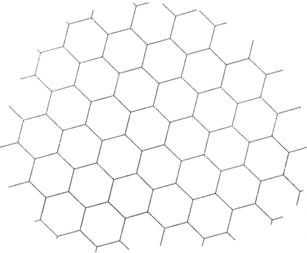
System characteristic: multiplicity in unity
With the question of the entirety of the characteristics of the world of life I arrived at the system of the Monad, unity, simplicity, wholeness. How does a number become a system? The systemic quality of a Monad is that it consists of many components that are related to each other and are mutually reciprocal to each other. But not each partial aspect belongs to a Monad, and the aspects must be related to the research topic. For instance you would add a marriage to the field of life but not how to fix a PC, although a PC might be important in your life.
This collection of thoughts and cues in a Monad is inexhaustible. If you once begin to think about that, all the more thoughts will occur in addition to the ones you already have stated. You should not underestimate this practice in any case, for it delivers valuable material for further action!
The third step now is to divide these factors into meaningful groups.
That is important because otherwise the trees block the view of the forest.
Living begins with learning - and it is life long.
A moth fluttered before a window on and off, because it had seen light in the area behind it. There a spider said to it: When will you moths learn finally that flames are hot and destructive? The glass protects you nevertheless. The moth laughed at the spider: I am not stupid, I know that the light which is in the room is ' cold light ' and does not burn me. She found a crack somehow and flew to the light. What she had not known yet was that one had sprayed insect poison on the lamp...
The acquisition of capacities is the first step of development in life. It doesn’t matter where life leads, always you will try to realize - deliberately or unconsciously - the entirely individual characteristics of your life goals. Learning already begins before birth. After that it intensifies itself extremely. The current brain research makes more and more clear that most nerve connections are designed by intensive training in infancy. Many capacities can be trained after puberty only with larger efforts. Scholastic learning and vocational education essentially establish further qualifications. In addition, work and occupation are aspects of high priority in our society, because one’s occupation determines a large part of one’s life.
The gaining of life experience and its deepening for the development of all human potentials is by far a more difficult venture. In addition, each life and the implementation of this process are subject to various imponderabilities and risks, which are rarely recognized in time and switched off. This is a good reason to represent life as an interlaced process, which must adapt itself to mutually affecting variables again and again.
One can state three basic life phases:
- The acquisition of abilities,
- The gaining of experiences and
- The realization of life goals.
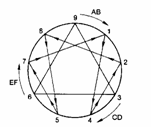
All three are interwoven with each other and enhance each other. However at the same time they are also concrete steps in a time sequence.
The life philosopher G. I. Gurdjieff (1866-1949) once said: "To know something means to know everything. Not to know everything is equivalent to ignorance. In order to know everything, it is necessary to know a little bit, but actually to know this little, one must know quite a lot." The systemic model of the Enneagram, a ninefold-system that was made known by Gurdjieff, gives the possibility to experience this little. In order to understand this model however, we must have won much experience. Then working with this model can be an infinite source of understanding and inspiration. While the Monad shows you the unity of diversity, the Enneagram lets one participate in the multiplicity of unity and helps to grasp the whole process.
We can get an intimation of this source if we relate this system to life, not to any abstract process. Life moreover has its own characteristic dynamics. If we learn to understand the interwoven complexity of our life process, it will be possible to recognize external influences and to bring our own life into the direction that we want to give it – in spite of occasional deviations. One could call this the "law of falling". Our usual experience is that each process flows in a temporal or linear sequence. Something is begun, worked through in a certain sequence and, at the end, the goal that we set ourselves is reached. There is a preparation phase that is due to an initiative, an application phase, and a phase of realization. However, in an interlinked world it is never guaranteed that a process reaches its goal without deviation.
If the process experiences a positive or negative input along the way, it can change direction in such a way that a new goal is achieved:
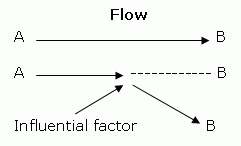
If one sees and considers this fact, a correction can be undertaken.
Exercise: Ask yourself once: when, how often, and why you undertook a correction in your life so far? Gather all instances which you can remember.
You will discover astonishing discontinuities, even if you do not feel that you have deviated along the way!
The "Enneagram" or Ennead is an extraordinary system, for it lets you understand the harmonious realization of a process. Even if single phases and aspects in this model are subdivided, the entirety of the Monad remains. Life is a unity, but within this unity, a differentiation is undertaken. We observe the parts and phases from the viewpoint of the whole.
The Ennead is a "non-linear" model because it connects spatial with temporal and conscious elements. I can only undertake a correction in a process if I interfere consciously or intentionally. And I can only interfere if I recognize the invisible "internal" flows of the process and understand the visible "external" influences.
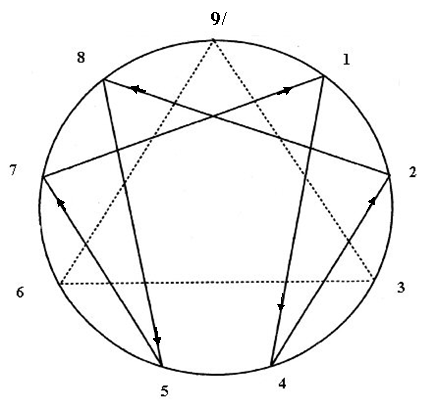
The Ennead consists of three systems. 1. Processes that are cyclic: the Circle
2. Processes having an internal connection and an intention: The Triangle
3. Processes which overlap and are coordinated: the periodic loop symbolized through the dynamic Hexad.

The Ennead is to be approached as a tool which can help to step from a linear view to a dynamic, integrated perception, a holistic view, which presents itself as three independent processes. The first threeness which we have to work with is the definition of the purpose of a process which we would like to understand.
What are the essential aspects of the question?
In my model example it is the lifelong process of the human development. The sides of the internal triangle correspond in my example to the three life phases of the points 0, 1, 2, 3 etc. That is the "temporal" flow. This flow of a life has intersection points with the life of other persons and the society in general. On these vertices of the internal triangle there are influences of impulses which I myself cannot control - only indirectly in so far as I consider these impulses.
It is important to understand that the impulses which come in at the vertices of the triad also have an impulse on the other vertices - however, this does not only works linearly from point 3 to 6 to 9, but also from 6 to 9/0 to 3 etc. The triad represents a virtual dynamics within the Ennead, which always renews itself again and again and is influenced through external or internal influences.
Realize your own vision
"To bring the concealed, invisible patterns into the visible world is a part of the work on the development of the capacity to become a conscious person, who is able to act intentionally." John G. Bennett
Obviously there are different opinions about the "meaning of life". One opinion however is uncontested in nearly every life philosophy: that a person, besides their physical growth, also passes through a mental and intellectual "growth". All three processes are closely interwoven.
"Growth" is in all cases a transformation, a transformation of matter into energy and consciousness. The acquisition of abilities has a different internal quality than the implementation of things, which become possible by our abilities, e.g. the production of a piece of furniture or the writing of a book. The acquired abilities are brought together with human experience into a concrete implementation. Vice versa the practical application of abilities can unfold further "internal" qualities. All these processes influence each other mutually.
The human life does not run simply "straight-lined" from the birth (past) through the life (present) up to death (future). Rather, this process is to be seen as a kind of cycle which contains different phases, each of which go through their own enneadic cycle. Each phase has a new and different quality, even if you are not conscious about the transformational steps.
In the first life phase we have to acquire the abilities that are necessary for grown-up life in society (phases 0-3). Learning and the acquisition of abilities are the main characteristics of this phase, first as a child, then as a youth and young person, until the first step into ones own life with an occupation or a position to earn a livelihood successfully. Obviously the learning never stops, and this phase remains part of the entire cycle until point 9 (and further...). In consideration of the classic threefold unity of "body, soul, spirit" this area corresponds to the physical, or functional called "body". How we learn in the second life phase depends on many possible internal and external factors.
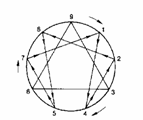
The second life phase is centered mainly in the collection of experiences, and in the conscious deepening of experiences (phases 4-6). This process includes not only work experience, relations, family etc. it can also enhance the search for spiritual questions – stronger in some people, weaker in other people, but sometime this question will be investigated in the second life phase. As in the prior phase experiences will never stop until the end of life. Nevertheless, one can say that the more conscious process of understanding and ones own intentionally created experiences, which we determine ourselves, start at a later time. I will return to that.
The third life phase begins with the awakening into a situation, which becomes decisive for the rest of life (phases 6-9). If humans have pursued the question of the meaning of life, it becomes clear to them that life is finite and they must strive ever more intensively for their internal development and dedicate themselves to the realization of their own soul pattern. Other humans without this adjustment possibly achieve the highest career stage, which they can realize with ambition and authority in an enterprise, a company or in politics in this phase. Even if humans concentrate mainly on wordly realizations or success, it can be that they do this in a way which also promotes their internal or mental development, although they are not directly aware of it. With or without career jump, with inner realization or without, this phase finally leads into old age and (point 9) into a further phase of transformation of which we know nothing.
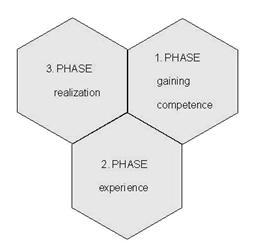
The corner points of the internal triad, the points 3, 6, and 9, mark crucial transformations in life. Point 3 is where humans are strongly influenced by external influences full of risks which are decisive for their further development. At point 6 internal conscious influences are of importance ("internal" in the sense that influences come from from the world of consciousness related to the individual consciousness), while at point 9 the "spiritual world", the "cosmic will", directs the further process. Now we try to view the three factors of influence and the three life phases together:
The first phase of the life cycle follows the temporal cycle clockwise until the first transformation in life at point 3. The clockwise direction goes from point 0 (conception) in the Ennead over point 1 (birth) and point 2 (learning and maturing) to point 3, independent adult life; i.e. in the first phase the focus lies on the functional development - physical, sensual, and intellectual learning. These determine the child and the young person. The foundations for emotional, social and creative intelligence are laid at this time.
The ninefoldness of the Ennead also permits the consequence that each temporal section likewise proceeds in "steps of 9": from point 0, the conception, until point 1, the birth, 9 months are needed (in the "quick-motion” view). This can be compared with the developments after the birth. From point 1 (birth) to point 2, growing up and first school years and conclusion of the first childhood phase, we go through 9 years. From point 2 up to the first large transformation around 18 years (point 3) again 9 years have passed (further explanations concerning this later).
"Today, where one worries oneself about the outward much more than about the internal, one gives this reversal in the 9th or 10th year of life much too little attention." Rudolf Steiner
The second phase begins with point 3 and runs now over the stages of recognizing and awaking ones own strength as well as the completion of education until point 4 - up to the age of 27 years. During this phase deep into the next phase sexuality and relations will play an important role. At point 5, at the age of 36 years, the spiritual question, “meaning of life”, or the question of vocational development is strengthened. Many humans, who become unemployed during this phase, therefore often fall into a mental "hole".
The period between the first point of influence 3 and the second point of influence 6 is a turbulent phase, in particular between 4 and 5, as life experiences and challenges affect most humans in western societies very intensively on many levels. With the beginning of the age of 36 some decisions may be met, but now slowly the internal influence comes from consciousness or the unconscious (depending upon opinion) with stronger impact.
At 45 years of age - at point 6 - a new change happens in many people. This new "push" begins nowadays between 45 and 50 - after the children are out of the house "and the dog is dead” (Jewish joke). With most people here starts a new life phase and the meaningful spiritual questions, for which previously there had been little time, grow stronger for many. "The emigration out of the personal biography" is a typical act for these people. In one example a woman in this age began, out of nothing, to start a new existence "like a twenty year-old". That is the direct connection of point 6 to 3. It frequently happens that this outbreak also leads out of the previous life, and that this person suddenly behaves again as if she were only 18-20 years old. Many people however begin to reinforce their spiritual search..
The dates should not to be taken too literally. For example, parting from the parents' house can happen just as often around 19 or 20, whereby already by age 16 violent separation processes have begun. The same applies to all other precise years. And nevertheless: after many inquiries and knowledge from the private acquaintance the numbers are plus or minus rather applicable. According to my opinion this sequence of nine years replaces the old seven year cycles of the astrological world view in certain respects, even if for mental development quite under the “surface” the seven year cycle may run parallel. Sometimes the cyclic planetary circulations, which are said to have an influence on personal behavior, coincide exactly with certain points in the Ennead. Make an inquiry, testing this in your circle of acquaintances! A psychological study with questionnaires would also be welcome...
The third life phase is now either determined by a career jump, new positions and responsibilities, and/or the work on the realization of one’s life vision. In many cases conscious, intentional decisions will be stronger than the emotional kind which determined the second phase.
Starting from the age of 54 humans will work on the realization of their life visions and their own soul pattern which might either be based in realization in the “material” life, or in the spiritual. If you reach the age of 63 you come into the phase of “mastership”. Such a person can become the model for younger humans and are able to pass on their wisdom and their knowledge. Internal development continues and with the age of 72 the third transformation begins – a jump into the spiritual unknown and into challenges, of which nobody knows anything. Perhaps the "older ones" should speak more about it. I think the phase starting from point 9 is at the same time the starting point for the conscious preparation for “life” after the physical life, similar to the unconscious preparation for life during the pregnancy (0-1). A new "octave" begins.
Who gets older than 81 will have many new possibilities to work on the "internal life". The "normal" life will then at some time “close” with death, which could however also be the door for a new phase - we do not know. If people get older than 81 very often it happens (I was told by a geriatric nurse) that these old people again behave as infants (the beginning phase of the Ennead)... if they did not have worked at the development of their essential qualities.
0 conception to birth – 9 months
1 birth to end of (little) childhood: 0–9 years
2 childhood to the starting of adult life: 9–18
3 adult life to end of acquisition of skills: 18–27
4 life of relations and establishing place in society: 27–36
5 development of inner life and/or professional career: 36-45
6 development of consciousness, changes in private life: 45-54
7 coming to ones own life vision: 54-63
8 getting to ones own realization: 63-72
9 reaching zenith of life, clear feeling of the inner master: 72-81
10 starting a new spiritual cycle: 81-90 and beyond.
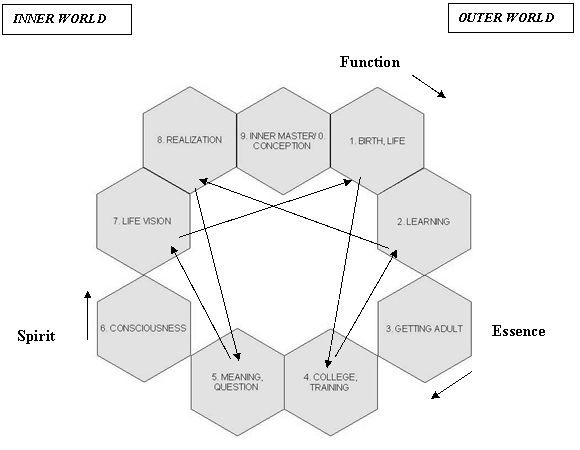
Now it is still important to regard the internal connections of the feedback loop. This shows interesting cross connections and influences within life processes, which one otherwise hardly considers.
We see in this diagram that starting with birth the internal pattern or the life vision of a person is already shaped (7-1). At the same time it shows a connection between the professional training and the personal life conception (7-1-4). The training of the functions has influence on the realization of the life pattern (2-8). This point determines the meaningful (spiritual) questions (8-5). If this is solved, a congruence of the life vision and the internal soul pattern (5-7) develops. All these connections are present at the same time and throughout the life process give new impacts again and again. In addition the direct (horizontal) connections of the points are equally important.
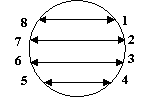
With birth (1) the will for the realization of ones own soul pattern also comes into the life (8) of humans. Some "wise" humans say that people intentionally decide their destiny. That would be the influence of point 8 on point 1. The direct relationship of point 7 to 2 carries the life vision into the development of the abilities. Therefore it occurs frequently that young people don’t behave according to the usual wishes of parents and adults. An internal wish pulls these young people, although they don’t know where and why. Point 2 also naturally affects point 7. You can study similar direct line relations with the other points, in order to understand developments, which otherwise remain in the dark.
At the points of risk 3 and 6 the personal development can be strengthened or weakened either from the outside or from the inside. At point 3, looked at from the periodical view coming into the age of approx. 18 years, the group and society has a strong influence. Statistically most accidents happen with young people at an age between 18 and 25, and between 16 and 21 years the criminality and accident rate are higher than otherwise. There are naturally also completely positive pushes in this time, which motivate young humans to train for a successful life.
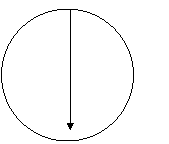
Between the age of 27 and 36 there will be new revolutions and crises. Close relationships (or marriage) will happen but also divorces from partners. After youth, this will be the most turbulent time of life for most humans. One can see this phase as direct reflection of point 9, from which the actual creative motivation of the life goal proceeds.
At point 6, at the age of approx. 45 years, the concrete effect of the spiritual crisis develops in many cases. Either these crises are used for development of the consciousness (internal impulse) or difficult times will begin, which have a strong influence on the remaining life design. Of course, the spiritual development will be a difficult time, too, but differently, because you know that you want more from life than material success
Exercise You can always test this Ennead in real life. Gather together the data of your own life and compare this to the corresponding points of the Enneagram. Try to find out whether there were marked points of change which have references like this to the other points of your own life.
Such a view is of special importance, because it connects the temporal operational sequence of the life with the driving conscious forces from the inside with your own vision so you might be able to understand the interwoven, systemic connections.
The Ennead is a dynamic system. It is based on the insight that each process is a movement, which does not run along straight-lined step by step, but it is a process which is interlaced within itself. Each part of the whole influences other parts. If a partial aspect and/or a factor is changed, that has effects on the whole process.
